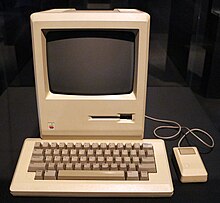
Back Macintosh 128K Catalan Macintosh 128K Czech Macintosh 128k German Macintosh 128K Spanish Macintosh 128K Estonian Macintosh 128K Basque Macintosh 128K Finnish Macintosh 128K French Macintosh 128K HT Macintosh 128K Hungarian
 All-in-one computer, monitor, and floppy drive with external keyboard and mouse | |
| Also known as | Macintosh |
|---|---|
| Manufacturer | Apple Computer, Inc. |
| Product family | Compact Macintosh |
| Type | All-in-one |
| Release date | January 24, 1984[1][2] |
| Introductory price | US$2,495 (equivalent to $7,300 in 2023) |
| Discontinued | October 1, 1985[3] |
| Units sold | 500,000 and over [citation needed] |
| Units shipped | 250,000 and over [citation needed] |
| Operating system | System Software 1.0[4] |
| CPU | Motorola 68000 @ 7.8336 MHz (6 MHz effectively)[5] |
| Memory | 128 KB RAM |
| Removable storage | 3+1⁄2 inch (9 cm) floppy disk |
| Display | 9 in (23 cm) monochrome, 512 × 342 |
| Dimensions | Height: 13.6 in (35 cm) Width: 9.6 in (24 cm) Depth: 10.9 in (28 cm) |
| Weight | 16.5 lb (7.5 kg) |
| Predecessor | Lisa |
| Successor | Macintosh 512K |
| Related | Apple IIe Apple IIc |
| Website | https://www.apple.com |
| Language | MacBASIC, MacPascal and the Macintosh 68000 Development System. |
The Macintosh, later rebranded as the Macintosh 128K, is the original Macintosh personal computer from Apple. It is the first successful mass-market all-in-one desktop personal computer with a graphical user interface, built-in screen and mouse. It was pivotal in establishing desktop publishing as a general office function. The motherboard, a 9 in (23 cm) CRT monochrome monitor, and a floppy drive are in a beige case with integrated carrying handle; it has a keyboard and single-button mouse.
The Macintosh was introduced by a television commercial titled "1984" during Super Bowl XVIII on January 22, 1984,[6] directed by Ridley Scott. Sales were strong at its initial release on January 24, 1984, at $2,495 (equivalent to $7,300 in 2023), and reached 70,000 units on May 3, 1984.[7] Upon the release of its successor, the Macintosh 512K, it was rebranded as the Macintosh 128K. The computer's model number is M0001.[8]
- ^ Linzmayer, Owen W. (2004). Apple Confidential 2.0. No Starch Press. p. 113. ISBN 1-59327-010-0. Archived from the original on January 23, 2022. Retrieved January 25, 2022.
- ^ "The Macintosh Product Introduction Plan". Stanford University Libraries & Academic Information Resources. Archived from the original on July 21, 2010.
- ^ "Macintosh 128K: Technical Specifications". apple.com. Archived from the original on February 17, 2015. Retrieved March 27, 2015.
- ^ "Official Apple Support". apple.com. Archived from the original on February 24, 2008. Retrieved January 21, 2008.
- ^ Smith, Burrell C. (February 1984). "Macintosh System Architecture". BYTE. Vol. 9, no. 2. p. 32.
- ^ Burnham, David (March 4, 1984). "The computer, the consumer and privacy". The New York Times. Washington, D.C. Archived from the original on April 3, 2015. Retrieved March 27, 2015.
- ^ Polsson, Ken (July 29, 2009). "Chronology of Apple Computer Personal Computers". Archived from the original on July 10, 2009. Retrieved August 27, 2009.
- ^ "How do you know if its the original Macintosh M0001 model?". MacRumors Forums. March 16, 2010. Archived from the original on October 26, 2016. Retrieved March 26, 2021.